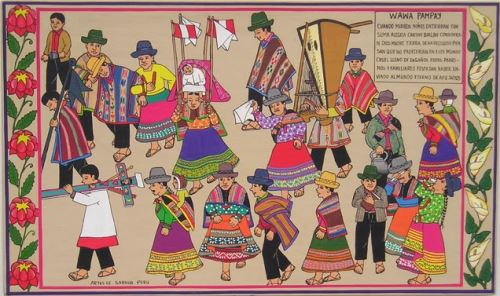Description
Las Tablas pintadas de Sarhua son una tradición cultural que se ha ido conservando durante varias generaciones en el pueblo de Sarhua de la provincia Victor Fajardo, en la región Ayacucho. Esta actividad económica es realizada por los pobladores hombres y mujeres con el propósito de salvaguardar la herencia, vida, uso y costumbres de la tradición familiar, antepasados y hechos importantes, constituyendo una herencia importante y una vía de comunicación como medio clave para ordenar la vida social del pueblo.
Las Tablas Pintadas de Sarhua poseen dos tamaños: las Tablas originarias que miden 2.5 metros y se utilizan como columnas de soporte de la viga principal del techo para una casa nueva, en esta se pintan escenas relacionadas a la genealogía familiar, los dioses tutelares y los santos católicos venerados por la familia. También suelen representar episodios de la historia familiar o momentos importantes del ciclo vital de su familia directa. Se acompañaban por textos breves escritos en quechua o español que identifican o comentan las escenas con un mensaje normativo o ejemplar.
Estas tablas grandes conllevan una ceremonia tradicional y ritual, son obsequiadas por los padrinos o compadres de techo a los dueños de casa. Los compadres recorren las calles cargando las tablas pintadas, acompañados de músicos, cantantes y botijeros que cargan los porongos de chicha de jora, quienes son recibidos por los dueños de casa con un banquete. A esta ceremonia de traslado se llama TABLA APAKUYKUY.
Las tablas pequeñas aparecen a partir de 1970, los artistas tradicionales de Sarhua deciden pintar tablas en pequeños formatos menores a 1 metro para que puedan ser comercializadas en los mercados artesanales, el traslado de la tradición a las tablas pintadas de pequeño formato implicó la conservación de la esencia de su técnica, cambios en el diseño, materiales utilizados y lo más importante incorporan nuevos temas alusivos donde se muestran escenas comunales como fiestas, costumbres y actividades agrícolas.
El proceso técnico empieza adecuando la madera, empastarla con el yeso y, una vez seca, se traza con el lápiz, para el pintado se utilizan tierras de colores que son elaborados artesanalmente en el lugar, los pigmentos se encuentran en los tintes de las plantas nativas (se obtiene color marrón), así mismo de la cochinilla (se obtiene color morado y rosado). De las cenizas se obtiene el color negro; en la actualidad algunos talleres usan anilinas y temperas para darle mayor vistosidad y diversidad de color
Las tablas pintadas de Sarhua han sido declaradas como Patrimonio Cultural de la Nación, también el pueblo de Sarhua ha sido declarado por el Estado Peruano como “Pueblo con Encanto” para impulsar el turismo, su artesanía y cultura.
Wnglish
Painted boards of Sarhua
The painted boards of Sarhua are a cultural tradition that has been preserved for several generations in the village of Sarhua in the province of Victor Fajardo, in the Ayacucho region. This economic activity is carried out by the villagers, men and women, with the purpose of safeguarding the heritage, life, use and customs of the family tradition, ancestors and important events, constituting an important heritage and a means of communication as a key means to order the social life of the village.
The original Tablas, which measure 2.5 metres and are used as support columns for the main beam of the roof of a new house, are painted with scenes related to the family genealogy, the tutelary gods and the Catholic saints venerated by the family. They also often depict episodes from the family history or important moments in the life cycle of their immediate family. They are accompanied by short texts written in Quechua or Spanish that identify or comment on the scenes with a normative or exemplary message. These tablas involve a traditional ceremony and ritual, and are given as gifts by the godfathers or compadres de techo to the owners of the house. The compadres go through the streets carrying the painted boards, accompanied by musicians, singers and ‘botijeros’ who carry the ‘porongos’ of chicha de jora, who are received by the owners of the house with a banquet. This transfer ceremony is called TABLA APAKUYKUY.
The small boards appear from 1970 onwards, the traditional artists of Sarhua decided to paint boards in small formats of less than 1 metre so that they could be commercialised in the artisan markets. The transfer of the tradition to the small format painted boards implied the conservation of the essence and changes in the design, and materials used. The most important thing they incorporate was new allusive themes such as festivities, customs and agricultural activities. The technical process begins by adapting the wood, and filling it with plaster. Once dry, it is traced with a pencil, coloured pigments are used for the painting, which are handmade locally. The pigments are found in the dyes of the native plants (brown colour is obtained), as well as from the cochineal (purple and pink colour is obtained). Black colour is obtained from ashes; nowadays, some workshops use aniline and tempera to give more colour and diversity of colour.
The painted boards of Sarhua have been declared as Cultural Patrimony of the Nation, also the town of Sarhua has been declared by the Peruvian State as “Town with Charm” to promote tourism, its handicrafts and culture.


Reviews
There are no reviews yet.